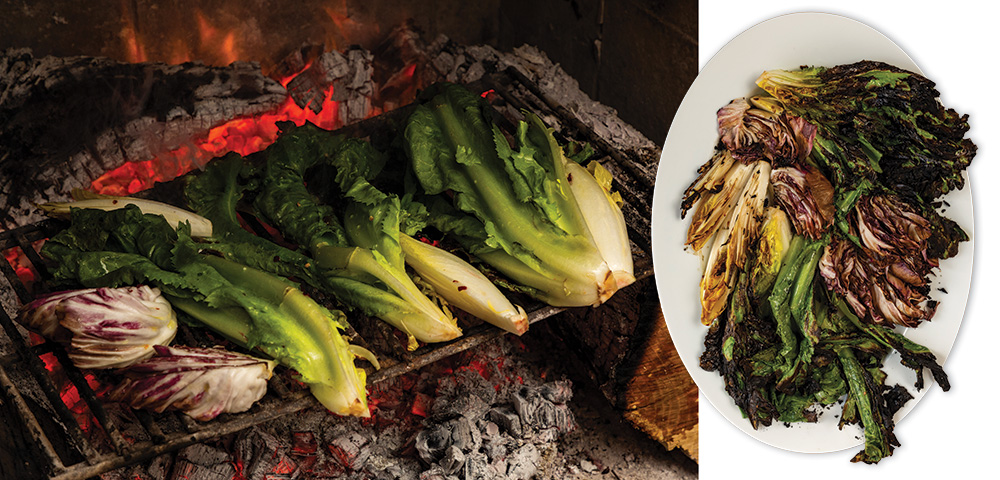
So, we’ve made it past the holidays. After the season of indulgence (and with the way my pants now fit) I know I should eat something clean and light like a salad. But when it’s chilly and bleak outside, we tend to crave savory foods both warm and comforting—and a pile of lettuce doesn’t really fit the bill. I have a solution that fulfills all of these requirements: grilled greens.
Exposing greens to extreme temperatures for a short amount of time lends a complexity that raw greens will never achieve, while still maintaining the sense of freshness. I am fortunate to have a wood-burning fireplace where I love to cook, and the burning wood and coals impart subtle smoky flavors that you achieve from no other source of heat. However, a gas or charcoal grill, a broiler, or even in a scorching hot cast-iron skillet can achieve similar wonderful results. Greens cooked with a bit of char can be used almost anywhere one would normally use fresh raw greens, but with a more primal, satisfying outcome. Examples: grilled Caesar salad; grilled escarole and new potatoes with sautéed trout and lemon; grilled wedges of radicchio (maybe wrapped in a slice of bacon) accompanying a roast chicken; spicy grilled frisée atop a mound of braised fava beans; grilled leaf lettuce used like the traditional Midwestern wilted lettuce salad with pickled onions, lemon, and bacon dressing. The variations are endless.
This recipe for grilled greens is a genesis point, a foundation for dishes that take ordinary salad greens to a whole new level. My favorite greens for grilling are members of the chicory family, like radicchio, Belgian endive and escarole. All of the chicory family members have a hint of bitterness, both delicate and sweet, (some more assertive) that the char of the grill seems to accentuate. But other greens like romaine, leaf lettuce, or cabbage seem to achieve an almost meaty quality. Here is my basic technique.
Preheat your grill, fireplace, broiler or other heat source so that it is extremely hot. Peel and slice a few cloves of garlic and place them in wide bowl with a few tablespoons of extra virgin olive oil, and a few flakes of crushed red pepper. Allow to sit for a few minutes while you prepare the greens. Fill a large bowl with cold water and set aside for soaking the greens.
To prep the greens (I’ll use a head of escarole in this example—the technique applies to all greens): Remove any blemished or damaged outside leaves from the head or any bits from the edges of leaves. Shave the bottom of the core if it is discolored, then cut through the core end of the escarole from core to leaf tip, leaving the leaves intact and attached. (Some leaf shapes, especially the frillier ones, seem to do better if you cut through the core and then pull the halves apart).
Next, in the same way, cutting through the core to keep the leaves attached, divide the head into manageable individual portions, probably six or eight (with Belgian endive, being much smaller, you only get two to four portions). Submerse the wedges into the large bowl of cold water and swish them around a bit. Allow them to sit for about ten minutes to allow any dirt or grit to settle to the bottom of the bowl. Remove the now-clean wedges from the water and shake off any excess, although a little water helps the greens to steam while cooking.
Place the drained greens into the bowl with the garlic infused oil. Sprinkle them generously with salt and something acidic like a few tablespoons of lemon juice, rice or wine vinegar. Toss well to coat. If the wedges seem like they might want to fall apart (or if you want to wrap them in a slice of bacon!), it can be helpful to skewer them before placing on a grill, which helps them hold together and facilitates turning. When ready to cook, place the wedges directly onto the grill or under the broiler, allowing them to char slightly before turning. You will learn your preferences for degree of char and doneness after your first experiment. Remove the greens to a platter and serve warm or at room temperature. Serve as is or dress with a favorite condiment. Any leftovers can be chopped and tossed into an omelet, soup, pasta sauce, savory grain salad, meat-pie filling—just use your imagination—and eat your healthy greens.

Left: Frisée
Airy and delicate, and frequently found in salad mixes, this chicory is the foundation for the classic French salad with bacon lardons, blue cheese, and apple. The Italian version, grilled and served over a puree of fava beans, is equally delicious. Available in grocery stores with larger produce departments, such as Cosentino’s.
Center: Curly Endive
Sturdy and dramatic, with interior leaves and exterior leaves that serve as almost different vegetables. Use the tender pale interior ones for raw preparations, and the tougher, darker exterior leaves in cooked preparations like grilling or in soups. Readily available in stores around the metro.
Right: Castelfranco Radicchio
One of the most gorgeous of Italian greens (it varies to from creamy white to pale green with burgundy speckles), Castelfranco is perfect as a base for a simple salad with nuts and cheeses, but equally able to compete with sweet and sour roasted duck, ginger, garlic, and soy. Castelfranco is readily available in Kansas City in more adventurous produce departments, such as Whole Foods in Brookside.


